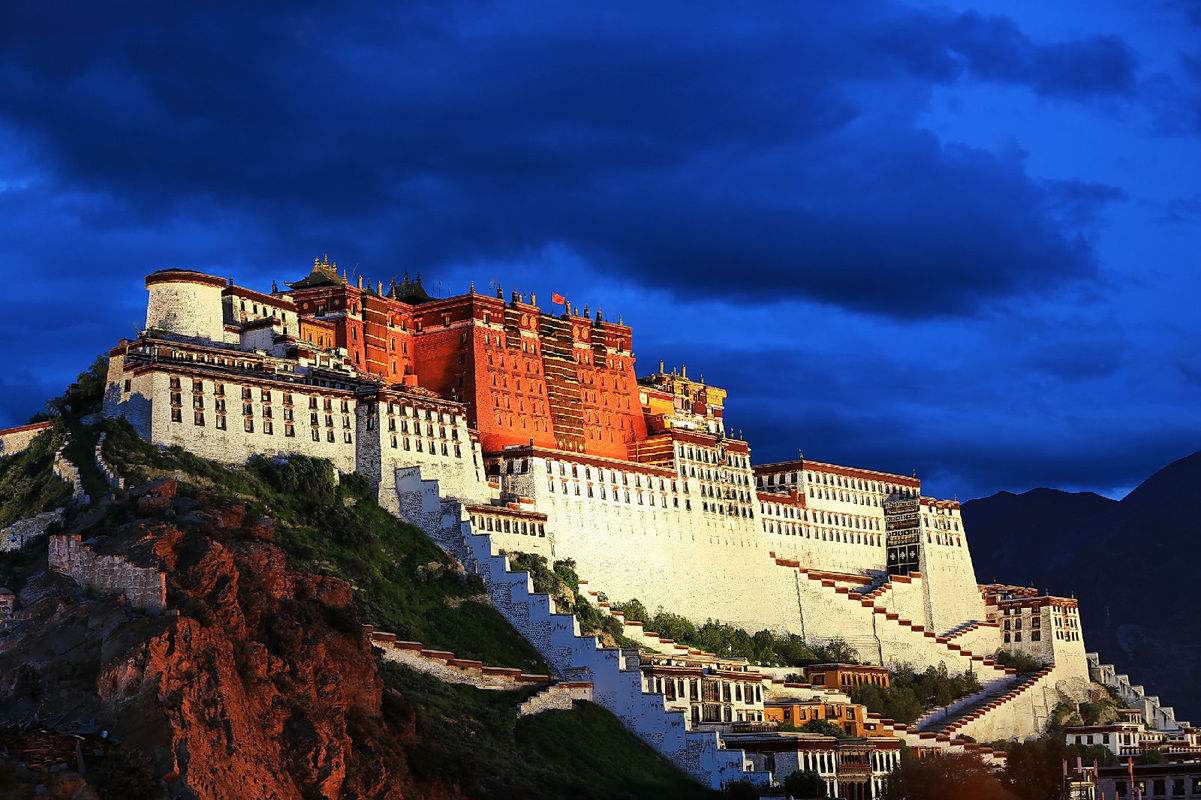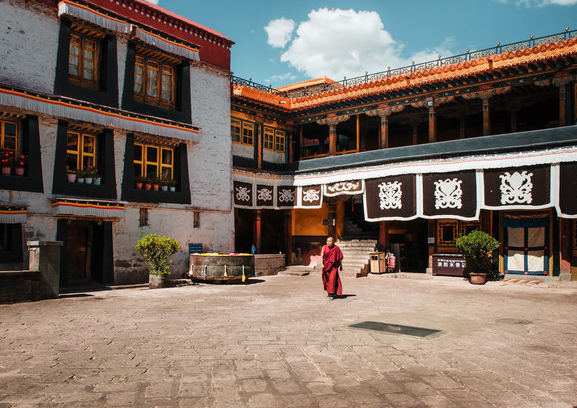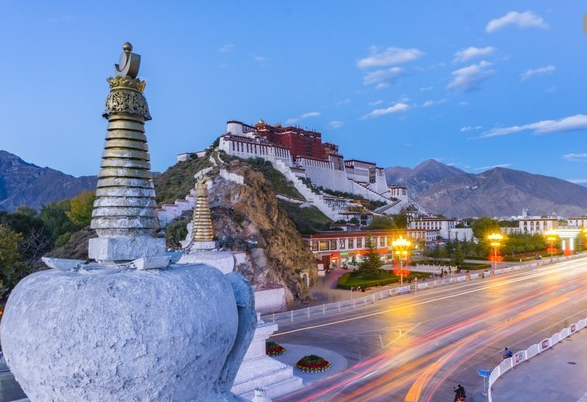24 Hours Hotline: +8613735411378
Email:chengdu@tripstoshanghai.com
24 Hours Hotline: +8613735411378
Email:chengdu@tripstoshanghai.com

Overview
By the mid 7th century, Songtsen Gampo became the leader of the Tibetan Empire that had risen to power in the Brahmaputra River (locally known as the Yarlung Tsangpo River) Valley. After conquering the kingdom of Zhangzhung in the west, he moved the capital from the Chingwa Taktsé Castle in Chongye County (pinyin: Qióngjié Xiàn), southwest of Yarlung, to Rasa (Lhasa) where in 637 he raised the first structures on the site of what is now the Potala Palace on Mount Marpori. In CE 639 and 641, Songtsen Gampo, who by this time had conquered the whole Tibetan region, is said to have contracted two alliance marriages, firstly to a Princess Bhrikuti of Nepal, and then, two years later, to Princess Wencheng of the Imperial Tang court. Bhrikuti is said to have converted him to Buddhism, which was also the faith attributed to his second wife Wencheng. In 641 he constructed the Jokhang (or Rasa Trülnang Tsulagkhang) and Ramoche Temples in Lhasa in order to house two Buddha statues, the Akshobhya Vajra (depicting the Buddha at the age of eight) and the Jowo Sakyamuni (depicting Buddha at the age of twelve), respectively brought to his court by the princesses. Lhasa suffered extensive damage under the reign of Langdarma in the 9th century, when the sacred sites were destroyed and desecrated and the empire fragmented.
A Tibetan tradition mentions that after Songtsen Gampo's death in 649 C.E., Chinese troops captured Lhasa and burnt the Red Palace. Chinese and Tibetan scholars have noted that the event is mentioned neither in the Chinese annals nor in the Tibetan manuscripts of Dunhuang. Li suggested that this tradition may derive from an interpolation. Tsepon W. D. Shakabpa believes that "those histories reporting the arrival of Chinese troops are not correct."
From the fall of the monarchy in the 9th century to the accession of the 5th Dalai Lama, the centre of political power in the Tibetan region was not situated in Lhasa. However, the importance of Lhasa as a religious site became increasingly significant as the centuries progressed. It was known as the centre of Tibet where Padmasambhava magically pinned down the earth demoness and built the foundation of the Jokhang Temple over her heart. Islam has been present since the 11th century in what is considered to have always been a monolithically Buddhist culture. Two Tibetan Muslim communities have lived in Lhasa with distinct homes, food and clothing, language, education, trade and traditional herbal medicine.

By the 15th century, the city of Lhasa had risen to prominence following the founding of three large Gelugpa monasteries by Je Tsongkhapa and his disciples. The three monasteries are Ganden, Sera and Drepung which were built as part of the puritanical Buddhist revival in Tibet. The scholarly achievements and political know-how of this Gelugpa Lineage eventually pushed Lhasa once more to centre stage.
The 5th Dalai Lama, Lobsang Gyatso (1617–1682), unified Tibet and moved the centre of his administration to Lhasa in 1642 with the help of Güshi Khan of the Khoshut. With Güshi Khan as a largely uninvolved overlord, the 5th Dalai Lama and his intimates established a civil administration which is referred to by historians as the Lhasa state. The core leadership of this government is also referred to as the Ganden Phodrang, and Lhasa thereafter became both the religious and political capital. In 1645, the reconstruction of the Potala Palace began on Red Hill. In 1648, the Potrang Karpo (White Palace) of the Potala was completed, and the Potala was used as a winter palace by the Dalai Lama from that time onwards. The Potrang Marpo (Red Palace) was added between 1690 and 1694. The name Potala is derived from Mount Potalaka, the mythical abode of the Dalai Lama's divine prototype, the Bodhisattva Avalokite?vara. The Jokhang Temple was also greatly expanded around this time. Although some wooden carvings and lintels of the Jokhang Temple date to the 7th century, the oldest of Lhasa's extant buildings, such as within the Potala Palace, the Jokhang and some of the monasteries and properties in the Old Quarter date to this second flowering in Lhasa's history.
By the end of the 17th century, Lhasa's Barkhor area formed a bustling market for foreign goods. The Jesuit missionary, Ippolito Desideri reported in 1716 that the city had a cosmopolitan community of Mongol, Chinese, Muscovite, Armenian, Kashmiri, Nepalese and Northern Indian traders. Tibet was exporting musk, gold, medicinal plants, furs and yak tails to far-flung markets, in exchange for sugar, tea, saffron, Persian turquoise, European amber and Mediterranean coral. The Qing dynasty army entered Lhasa in 1720, and the Qing government sent resident commissioners, called the Ambans, to Lhasa. In November 11 of 1750, the murder of the regent by the Ambans triggered a riot in the city that left more than a hundred people killed, including the Ambans. After suppressing the rebels, Qing Qianlong Emperor reorganized the Tibetan government and set up the governing council called Kashag in Lhasa in 1751.

In 1904 a British expedition force led by Francis Younghusband entered Lhasa and forced remaining low-level Tibetan officials to sign the Treaty of Lhasa after the fleeing of Dalai Lama. The treaty was subsequently repudiated and was succeeded by a 1906 Anglo-Chinese treaty. All Qing troops left Lhasa after the Xinhai Lhasa turmoil in 1912.
By the 20th century, Lhasa, long a beacon for both Tibetan and foreign Buddhists, had numerous ethnically and religiously distinct communities, among them Kashmiri Muslims, Ladakhi merchants, Sikh converts to Islam, and Chinese traders and officials. The Kashmiri Muslims (Khache) trace their arrival in Lhasa to the Muslim saint of Patna, Khair ud-Din, contemporary with the 5th Dalai Lama. Chinese Muslims lived in a quarter to the south, and Newar merchants from Kathmandu to the north of the Barkhor market. Residents of the Lubu neighbourhood were descended from Chinese vegetable farmers who stayed over after accompanying an Amban from Sichuan in the mid-nineteenth century; some later intermarried with Tibetan women and spoke Tibetan as their first language. The city's merchants catered to all kinds of tastes, importing even Australian butter and British whisky. In the 1940s, according to Heinrich Harrer:-
'There is nothing one cannot buy, or at least order. One even finds the Elizabeth Arden specialties, and there is a keen demand for them. . .You can order, too, sewing machines, radio sets and gramophones and hunt up Bing Crosby records.'
After the establishment of Communist Chinese People's Republic of China, " the People's Liberation Army (PLA) invaded the country in 1950. In March 1959, an uprising centered on the capital, Lhasa, prompted a massive crackdown, during which the Dalai Lama, Tenzin Gyatso (b. 1935), fled into exile." Such markets and consumerism came to an abrupt end after the arrival of Chinese government troops and administrative cadres in 1950. Food rations and poorly stocked government stores replaced the old markets, until the 1990s when commerce in international wares once more returned to Lhasa, and arcades and malls with a cornucopia of goods sprang up.
Of the 22 parks (lingkas) which surrounded the city of Lhasa, most of them over half a mile in length, where the people of Lhasa were accustomed to picnic, only three survive today: the Norbulingka, Dalai Lama's Summer Palace, constructed by the 7th Dalai Lama; a small part of the Shugtri Lingka, and the Lukhang. Dormitory blocks, offices and army barracks are built over the rest.
The Guandì miào (???) or Gesar Lhakhang temple was erected by the Amban in 1792 atop Mount Bamare 3 kilometres (2 miles) south of the Potala to celebrate the defeat of an invading Gurkha army.
The main gate to the city of Lhasa used to run through the large Pargo Kaling chorten and contained holy relics of the Buddha Mindukpa.
Between 1987–1989 Lhasa experienced major demonstrations, led by monks and nuns, against the Chinese Government. After Deng Xiaoping's southern tour in 1992, Lhasa was mandated by the government to undergo economic liberalization. All government employees, their families and students were forbidden from practicing their religion, while monks and nuns were not allowed to enter government offices and the Tibet University campus. Subsequent to the introduction of the economic development policies, the influx of migrants has dramatically altered the city's ethnic mix in Lhasa.
In 2000 the urbanised area covered 53 square kilometres (20 sq mi), with a population of around 170,000. Official statistics of the metropolitan area report that 70 percent are Tibetan, 34.3 are Han, and the remaining 2.7 Hui, though outside observers suspect that non-Tibetans account for some 50–70 percent. Among the Han immigrants, Lhasa is known as ‘Little Sichuan'
Prev: No previous link
Next: Lhasa Weather & Climate
Wechat: Chinaprivatetour
24 Hours Hotline:
+8613735411378
1 to 1 tailor-made service from our professional travel advisors for the most sophisticated
Constantly excellent reviews for attraction, hotel and service Competitive price
Local experts provide quality tours Best selected knowledgeable local guides Authentic local restaurants
7*24 hours available to create you a worry-free tour. No Hidden Fees and absolutely no pressure to buy. Secured







